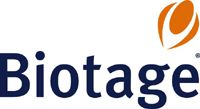Extraction of Ethyl Glucuronide (EtG) from Urine Using EVOLUTE AX for LC–MS–MS Analysis
Biotage Application Note
This application note describes an efficient, effective and sensitive analytical procedure for the extraction of ethyl glucuronide from human urine at low concentrations using EVOLUTE AX; a polymer-based mixedmode sorbent with an optimized combination of non-polar (hydrophobic), polar (hydrophilic) and strong anion exchange interactions.
Introduction
Ethyl glucuronide (EtG) is an ethanol metabolite formed by glucuronidation of the parent molecule. The presence of EtG in urine is a useful and sensitive bio-marker of ingested alcohol intake in forensic toxicology. Rapid and reliable methods with robust extraction protocols are essential for analysis and quantification of EtG from various matrices.
Extraction Conditions
This application note outlines a high throughput procedure using the 25 mg 96-well plate format (part #603-0025-P01) for processing 50 µL urine samples. The procedure can be scaled up for sample volumes up to 1 mL using larger EVOLUTE AX SPE column formats.1 Method parameters have been optimized to maximize analyte recovery and minimize ion suppression.
Sample: urine (50 µL) spiked at 500 ng/mL with EtG
Sample pre-treatment: urine (50 µL) with acetonitrile (950 µL)
Plate conditioning: methanol (1 mL)
Plate equilibration 1: water (1 mL)
Column equilibration 2: acetonitrile (1 mL)
Sample loading: pre-treated sample (1 mL)
Interference elution 1: water (1 mL)
Interference elution 2: acetonitrile (1 mL)
Analyte elution: acetonitrile:water:formic acid, (1 mL, 95:4:1, v/v)
Post extraction: evaporate to dryness and reconstitute with water/methanol (200 µL, 80:20, v/v) for LC–MS–MS analysis
LC–MS–MS Conditions
Instrument: Waters Acquity UPLC (Waters Corp., Milford, Massachusetts, USA)
Column: Acquity UPLC BEH C18 column (1.7µm, 50 × 2.1 mm i.d.) (Waters)
Mobile phase: Isocratic, 0.1% (v/v) formic acid aq/Methanol (80:20, v/v) at a flow-rate of 0.5 mL/min
Injection volume: 10 µL
Column temperature: 40 °C
Instrument: Premier XE triple quadrupole mass spectrometer (Waters) equipped with an electrospray interface for mass analysis. Negative ions were acquired in the multiple reaction monitoring mode (MRM); 21 > 84.9 (quantifier), 221.0 > 74.9 (qualifier)
Desolvation temperature: 450 °C
Ion source temperature: 150 °C
Collision gas pressure: 3.46 × 10–3 mbar
Results
EtG recoveries of over 80% with RSDs below 10% (n = 6) were achieved across the range of EVOLUTE AX formats and sample volumes using this procedure. Figure 1 shows the mass chromatogram for ethyl glucuronide extracted from 50 µL urine using this procedure (2.5 ng on column).

Figure 1: SRM chromatogram of extracted ethyl glucuronide.
Conclusions
This procedure provides for robust and effective extraction of EtG optimized for LC–MS–MS analysis. The use of the mixedmode EVOLUTE AX in this procedure allows the removal of endogenous urine components without analyte loss, leading to high analyte recoveries and low ion suppression.
References
1. L Williams et al., Extraction of Ethyl glucuronide (EtG) from urine using EVOLUTE AX. Application Note AN 705 (available from www.biotage.com).

Biotage AB
Kungsgatan 76 , SE-753 18 Uppsala, Sweden
tel: +46 18 56 59 00 fax: +46 18 59 19 22
E-mail: info@biotage.com Website: www.biotage.com

Removing Double-Stranded RNA Impurities Using Chromatography
April 8th 2025Researchers from Agency for Science, Technology and Research in Singapore recently published a review article exploring how chromatography can be used to remove double-stranded RNA impurities during mRNA therapeutics production.



















